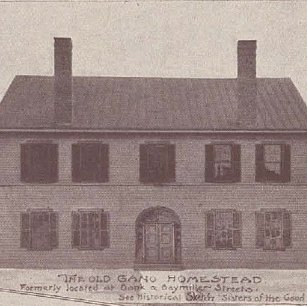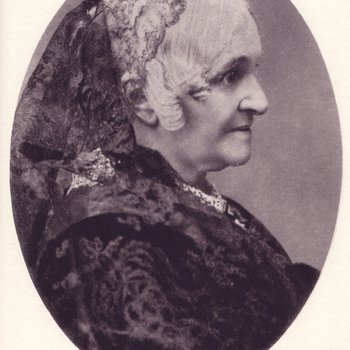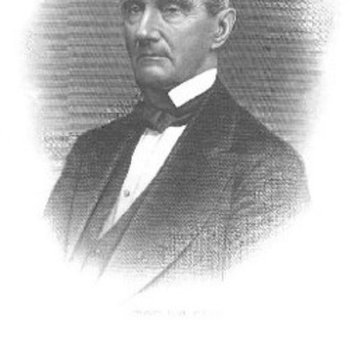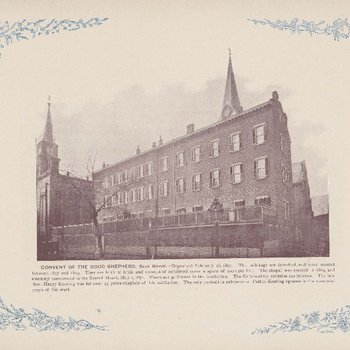Remembering Girls' Town of America, Cincinnati, Ohio
Early years in Cincinnati, Ohio
In 1857, a small group of Sisters of the Good Shepherd arrived in Cincinnati from Louisville, KY, where they had first come in 1842 at the request of Bishop Flaget. The Sisters shared Mrs. Sarah Peter's residence for a time, then moved into a frame structure at the corner of Bank and Baymiller Streets that had been the homestead of the Ganos, a prominent Cincinnati Catholic family.
Sarah Worthington King Peter
Sarah Worthington King Peter (1800-1877), a wealthy widow and Catholic convert, was instrumental in bringing the Order to Cincinnati.
Sarah Peter was the daughter of Thomas Worthington, the sixth governor of Ohio and its first senator; and the widow of Edward King, a prominent lawyer, and, later, of William Peter, the British consul to Philadelphia. She traveled frequently to Europe, where she first met the Sisters of the Good Shepherd in Rome and often stayed at their motherhouse in Angers, France. She convinced three other orders to establish convents in Cincinnati, as well: the Sisters of Mercy, the Little Sisters of the Poor, and the Franciscan Sisters.
Reuben Runyan Springer
Reuben Runyan Springer (1800-1884), a prominent Cincinnati philanthropist, was a significant benefactor of the Sisters of the Good Shepherd. He is best known for his role in establishing Cincinnati's Music Hall and the College Conservatory of Music. Springer made his fortune early, becoming a partner in Kilgour, Taylor and Company, Cincinnati's leading wholesale grocery firm, after marrying Jane Kilgour, his partner's daughter. His wealth grew through investments in banking, railroads, and real estate, allowing him to retire due to declining health at age 40. He and his wife then traveled extensively in Europe, immersing themselves in culture. Springer was not raised with strong religious beliefs, but his wife came from a prominent Catholic family. He embraced her religion and was a generous supporter of Catholic institutions including St. Peter in Chains Cathedral, the Convent of the Good Shepherd, a home for wayward girls, and numerous hospitals and orphanages.
Bank Street Convent
"Organized February 26, 1857. The buildings are detached and were erected between 1857 and 1859. They are built of brick and stone, and combined cover a space of 200 x 300 feet. The chapel was erected in 1869, and solemnly consecrated to the Sacred Heart, May 1, 1871. There are 40 Sisters in the institution. The Reformatory contains 100 inmates. The late Rev. Henry Koering was for over 33 years chaplain of this institution." (Source: Souvenir Album of American cities: Catholic Churches of Cincinnati and Hamilton County edition, 1896. Public Library of Cincinnati and Hamilton County.)
According to a short history published by the Sisters for their 1957 centenary, the school on Bank Street "opened to colored girls of the area in 1886, which work was later transferred to the country site [in Carthage]." (source: Centenary of the Sisters of the Good Shepherd in Cincinnati 1857-1957 [printed booklet], [1957?], p.20)
Women's Prison and House of Reform
While the Cincinnati Workhouse was under construction in the late 1860's, the city put the Sisters of the Good Shepherd in charge of female offenders at a former schoolhouse on Front street, that had been converted to a House of Reform, or Correction. After female prisoners were sent to the Workhouse in late 1869, the Sisters continued to operate a school of reform in the Front street location, where about 40 women "support[ed] themselves by their needle, with the aid of some kind friends, and serve their God untainted and unallured by the temptations of the world." (Catholic Telegraph, Sept. 8, 1870)
The city took back the facility from the Sisters in the early 1870's, at which time "the Mother Provincial bought a piece of ground near Carthage and built on it a sufficiently large house to accommodate the children of preservation and leave plenty of room at Bank street for women who desire to reform. At the same time one of the Sisters who had directed the House of Reform, found means to buy a house on Baum street, in which females of all ages are received." ("House of Reform," Catholic Telegraph, July 17, 1873, p. 4)
Next section: The Move to Carthage




